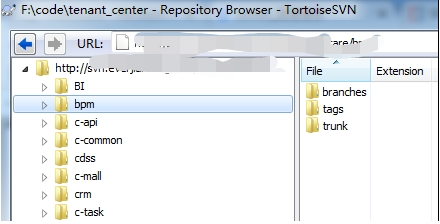SVNKit是JAVA操作SVN的一个jar包,里面提供了各种丰富的方法,看了很多大神的博客,了解了SVNKit的结构,这里不再细说。
简单介绍下前台查看SVN Tree的一种后台实现方式。这里并没有采用递归方式。

这里简单思考下我们应该设计什么样的接口来满足前段的需求,上图只是小乌龟的界面,前台树状图也差不多是这个形状,姑且先这样理解前台界面,
每次当前台点击△传递给我们一个当前的SVN URL,我们返回前台下层目录或文件以及URL,这样后台的接口基本上可以确定,我们需要的参数一定有URL,我们操作小乌龟的时候会用到用户名和密码,这样简单的参数我们就锁定了,
分别是,URL,用户名,密码。
public static List<SVNKitInfoDto> getSVNTreeInfo(String url, String userName, String passWord);
现在我们来看下代码实现
package com.thc.tenantcenter.util;
import java.util.ArrayList;
import java.util.Collection;
import java.util.Date;
import java.util.Iterator;
import java.util.List;
import org.apache.commons.logging.Log;
import org.apache.commons.logging.LogFactory;
import org.springframework.util.StringUtils;
import org.tmatesoft.svn.core.SVNDirEntry;
import org.tmatesoft.svn.core.SVNException;
import org.tmatesoft.svn.core.SVNLogEntry;
import org.tmatesoft.svn.core.SVNURL;
import org.tmatesoft.svn.core.auth.ISVNAuthenticationManager;
import org.tmatesoft.svn.core.internal.io.dav.DAVRepositoryFactory;
import org.tmatesoft.svn.core.io.SVNRepository;
import org.tmatesoft.svn.core.io.SVNRepositoryFactory;
import org.tmatesoft.svn.core.wc.SVNWCUtil;
import com.thc.tenantcenter.constant.TenantcentConstant;
import com.thc.tenantcenter.dto.SVNKitInfoDto;
/**
* @Description: 利用SVNKit进行SVN 提交 修改 查询 删除等操作
*
********************************************************
* @author @date @version
* author 2017年11月15日 1.0.0
********************************************************
* @update
*/
public class SVNKitUtils {
private static final Log LOG = LogFactory.getLog(SVNKitUtils.class);
private static final String HOME_SVN_URL = "http://svn.everjiankang.com/svn/healthcare";
private static final Integer LOG_NUM = 5;
/**
*
* @Description: 获取SVNTree
* @param url svn
* @param userName
* @param passWord
* @return
*
* @author: author
* @date: 2017年11月15日
* @version: 1.0.0
*/
public static List<SVNKitInfoDto> getSVNTreeInfo(String url, String userName, String passWord) {
if (StringUtils.isEmpty(url)) {
url = HOME_SVN_URL;
}
return getSVNTreeInfos(getSVNRepository(url, userName, passWord));
}
/**
*
* @Description: 获取SVN版本号集合
* @param url
* @param userName
* @param passWord
* @param startDate
* @return
*
* @author: author
* @date: 2017年11月15日
* @version: 1.0.0
*/
public static SVNKitInfoDto getSVNVersions(String url, String userName, String passWord, Date startDate) {
SVNKitInfoDto sVNKitInfoDto = new SVNKitInfoDto();
try {
sVNKitInfoDto.setFileUrl(url);
sVNKitInfoDto.setVersionNos(getSVNVersions(getSVNRepository(url, userName, passWord), startDate));
} catch (SVNException e) {
LOG.error("SVNKitUtils getSVNVersions is error", e);
}
return sVNKitInfoDto;
}
/**
* @Description: 获取SVNRepository
* @return sVNRepository
*
* @author: author
* @date: 2017年11月15日
* @version: 1.0.0
*/
private static SVNRepository getSVNRepository(String url, String userName, String passWord) {
//1.根据访问协议初始化工厂
DAVRepositoryFactory.setup();;
//2.初始化仓库
SVNRepository svnRepository = null;
try {
svnRepository = SVNRepositoryFactory.create(SVNURL.parseURIEncoded(url));
} catch (SVNException e) {
LOG.error("SVNKitUtils getSVNRepository is error", e);
}
//3.创建一个访问的权限
char[] pwd = passWord.toCharArray();
ISVNAuthenticationManager authenticationManager = SVNWCUtil.createDefaultAuthenticationManager(userName, pwd);
svnRepository.setAuthenticationManager(authenticationManager);
return svnRepository;
}
/**
* @Description: 获取路径以及历史版本号
* @param svnRepository
*
* @author: author
* @date: 2017年11月15日
* @version: 1.0.0
*/
@SuppressWarnings("unchecked")
private static List<SVNKitInfoDto> getSVNTreeInfos(SVNRepository svnRepository){
List<SVNKitInfoDto> svnDtoInfos = new ArrayList<>();
try {
Collection<SVNDirEntry> entry = svnRepository.getDir(TenantcentConstant.EMPTY, -1 ,null,(Collection<SVNDirEntry>)null);
for (SVNDirEntry svnDirEntry : entry) {
SVNKitInfoDto svnDtoInfo = new SVNKitInfoDto();
svnDtoInfo.setFileName(svnDirEntry.getName());
svnDtoInfo.setFileUrl(svnDirEntry.getURL().toString());
svnDtoInfos.add(svnDtoInfo);
}
} catch (SVNException e) {
LOG.error("SVNKitUtils getSVNRepository is error", e);
}
return svnDtoInfos;
}
/**
*
* @Description: 获取SVN历史
* @param svnRepository
* @throws SVNException
*
* @author: author
* @date: 2017年11月15日
* @version: 1.0.0
* @param startDate
*/
@SuppressWarnings("rawtypes")
private static List<Long> getSVNVersions(SVNRepository svnRepository, Date startDate) throws SVNException {
List<Long> versions = new ArrayList<>();
Collection logEntries = svnRepository.log(new String[]{""}, null, svnRepository.getDatedRevision(startDate), svnRepository.getLatestRevision(), true, true);
Iterator it = logEntries.iterator();
while (it.hasNext()){
SVNLogEntry svnLogEntry = (SVNLogEntry)it.next();
versions.add(svnLogEntry.getRevision());
}
return getLimitLogNum(versions);
}
/**
*
* @Description: 只取最新的版本号中的五条
* @param versions 所有版本号集合
* @return
*
* @author: author
* @date: 2017年11月15日
* @version: 1.0.0
*/
private static List<Long> getLimitLogNum(List<Long> versions) {
if (versions.size() <= LOG_NUM) {
return versions;
}
List<Long> limitVersions = new ArrayList<>();
for (int i = 0; i < versions.size(); i++) {
if (i > versions.size() - 1 - LOG_NUM) {
limitVersions.add(versions.get(i));
}
}
return limitVersions;
}
}
首先拿到SVNRepository这里需要做的事情要给定URL和用户名还有密码,接着调用getDir方法获取目录结构,到这里目录结构或文件我们已经获取完毕。封装成一个DTO返回给前台,这样任务就算简单的完成。这里这是给的SVNKitUtil,接口还是要自己去写
以上代码还提供了查看文件的版本号,当然我用到的是公司系统自动化构建,可能小伙伴不太需要,简单的说下实现思路。
第一步:拿到SVNRepository
第二步:取开始时间的版本号
第三步:调用log方法
第四步:返回版本号开始时间到最新版本号集合
当然这里是可以扩展成时间段的版本号等。
以上只是简单的例子,具体参数含义查看官方api:https://svnkit.com/javadoc/index.html
希望能帮助童鞋们,如果有什么地方不是很清楚的,欢迎留言!